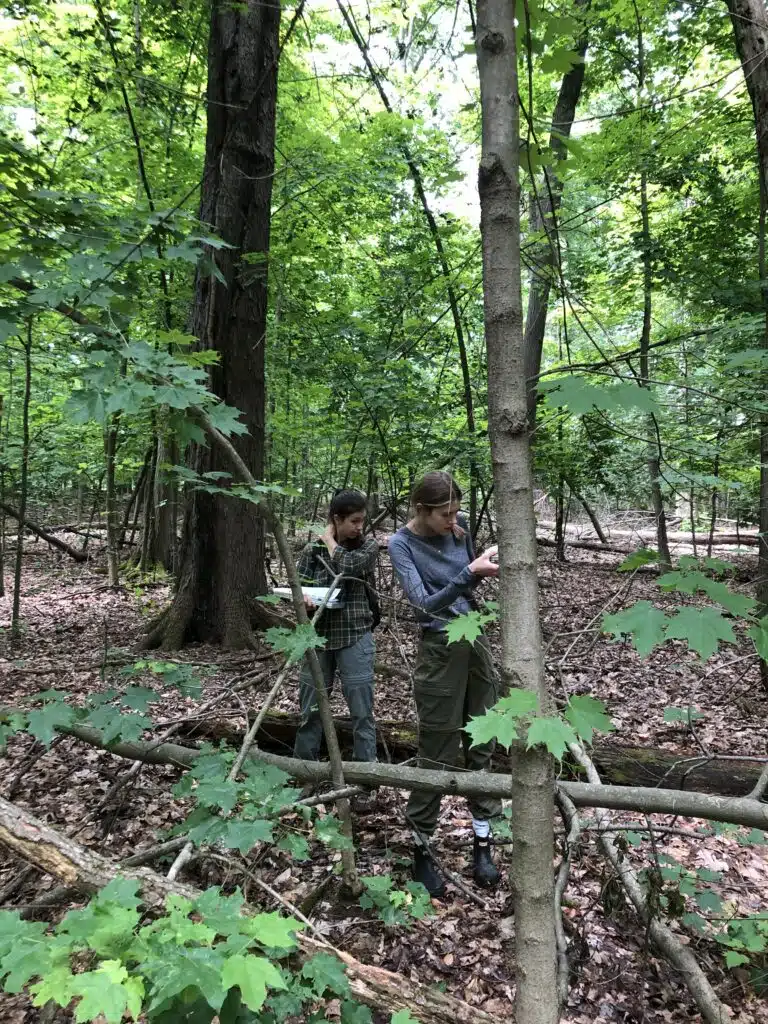Study Shows Forest Soils Still Bear the Scars of Industrial Pollution
April 28, 2025

KIRTLAND, OHIO — After 12 years of carefully tracking tree growth and soil chemistry, researchers at Holden Forests & Gardens (HF&G) have confirmed that phosphorus is now a limiting nutrient in northeastern Ohio forests—likely a sign of long-term industrial pollution. Some trees benefit more than others when forest nutrient balance is restored, revealing how long-term changes in soil chemistry are reshaping forest ecosystems.
In forests and gardens alike, plants rely on certain nutrients in the soil, like nitrogen and phosphorus, to grow. While these nutrients occur naturally in healthy soil, many gardeners know them best as the key ingredients in fertilizer. A “limiting nutrient” is the one that’s in shortest supply: Even if everything else a plant needs is present, growth can slow or stop if that one nutrient is missing. Soil pH is another important factor; it measures how acidic or alkaline the soil is, which affects how available nutrients are to plants.
Decades ago, industrial air pollution in northeastern Ohio led to both acid rain and nitrogen deposition, which altered forest soils in lasting ways. These impacts made soils more acidic and added excess nitrogen, disrupting the natural balance of nutrients that trees rely on. Although regulations have reduced acid rain and nitrogen emissions today, their legacy lingers. Soil acidity and altered nutrient levels continue to influence tree health and growth, and researchers are still working to understand how to help forests recover and thrive.
In a long-term study published in Ecosphere, researchers added phosphorus and lime (a crushed limestone product commonly used to reduce acidity) to test how soil nutrients and acidity affect tree growth in mature forests at the Holden Arboretum and Case Western Reserve’s Squire Valleevue and Valley Ridge Farms. Trees that received phosphorus additions grew significantly more over the study period than those in untreated plots, especially in the first six years. Surprisingly, adding both phosphorus and lime did not increase growth more than phosphorus alone.

The study was led by Lydia Jahn, former Norweb Fellow and research specialist, and Dr. Sarah Carrino-Kyker, postdoctoral research associate, both in the David Burke lab at Holden Forests & Gardens. Jahn is now a J.D. Candidate at UC Berkeley School of Law.
“Temperate forests are generally considered to be nitrogen-limited.” says Carrino-Kyker. “But our study showed that these forests may be more phosphorus limited than we previously thought—and the fact that we were able to track these changes over 12 years makes that finding even more powerful.”
The team also studied how different types of trees responded. Some trees form partnerships with fungi called arbuscular mycorrhizae (AMF) that live in their roots and help them take up nutrients from the soil. Others associate with ectomycorrhizal fungi, which grow on the outside of tree roots and support different nutrient exchanges. They found that trees with AMF, like red and sugar maples, were more likely to benefit from phosphorus fertilization. Ectomycorrhizal species, such as oak and hickory, were less responsive.
“These nutrient additions didn’t just help trees grow more,” says Dr. David Burke, Vice President for Science and Conservation at Holden Forests & Gardens. “Because some trees responded more favorably than others to the additions, this will favor certain species over time, reshaping the forest.”
Although the limestone treatments did raise soil pH, which in turn also made calcium and magnesium—nutrients often depleted in acidic soils—more available, these changes didn’t result in greater tree growth. These changes did result in altered abundance of mycorrhizae, however. The results underscore the complex relationship between soil chemistry, fungal partnerships, and long-term forest health.
The study provides one of the longest-running datasets on phosphorus limitation in eastern U.S. forests, helping to clarify how changes in nutrient availability can ripple through forest ecosystems.
Citation: Jahn, Lydia V., Sarah R. Carrino-Kyker, Alexa R. Busby, and David J. Burke. “Phosphorous fertilization and soil pH affect the growth of deciduous trees in a temperate hardwood forest.” Ecosphere 16 (2025): e70184.
About Holden Forests & Gardens: Holden Forests & Gardens is made up of two of Northeast Ohio’s most important environmental and cultural institutions—the Holden Arboretum and Cleveland Botanical Garden—whose mission is to connect people with the wonder, beauty, and value of trees and plants, to inspire action for healthy communities. One of the largest public gardens in the country, HF&G has 21,000 member households and an annual attendance of nearly 350,000 for whom we strive to provide inspirational and educational visitor experiences.
Corresponding Author:
Dr. Sarah Carrino-Kyker
Postdoctoral Research Associate
Holden Forests & Gardens
skyker@holdenfg.org
Media Contact:
Dr. Anna Funk
Science Communications Specialist
Holden Forests & Gardens
afunk@holdenfg.org

Anna Funk, PhD
Science Communications Specialist
Anna Funk is the Science Communication Specialist for Holden Forests & Gardens. She earned her Ph.D. studying prairie restoration before leaving the research world to help tell scientists’ stories. Today, she wears many hats, working as a writer, editor, journalist and more — anything that lets her share her appreciation of science and its impact with others.












